nForce 500: nForce4 on Steroids?
by Gary Key & Wesley Fink on May 24, 2006 8:00 AM EST- Posted in
- CPUs
Synthetic Graphics Performance
The 3DMark series of benchmarks developed and provided by Futuremark are among the most widely used tools for benchmark reporting and comparisons. Although the benchmarks are very useful for providing apples-to-apples comparisons across a broad array of GPU and CPU configurations, they are not a substitute for actual application and gaming benchmarks. In this sense we consider the 3DMark benchmarks to be purely synthetic in nature but still valuable for providing consistent measurements of performance.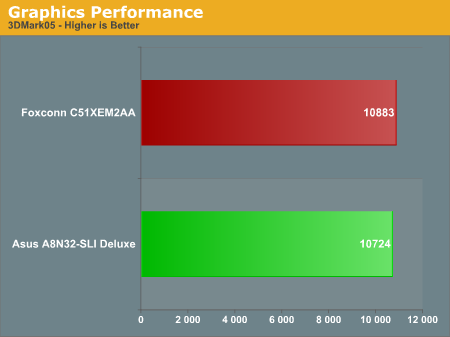
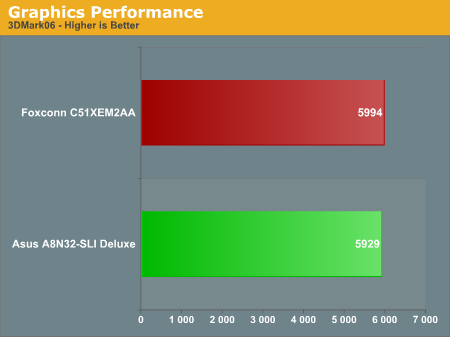
Our nForce 590 SLI system improves upon the performance of the nForce4 system by an average of 1%. These test results are basically a tie and indicates both platforms are performing equally with the same video card.
General System Performance
The PCMark05 benchmark developed and provided by Futuremark was designed for determining overall system performance for the typical home computing user. This tool provides both system and component level benchmarking results utilizing subsets of real world applications or programs. This benchmark is useful for providing comparative results across a broad array of Graphics subsystems, CPU, Hard Disk, and Memory configurations along with multithreading results. In this sense we consider the PCMark benchmark to be both synthetic and real world in nature while providing consistency in our benchmark results.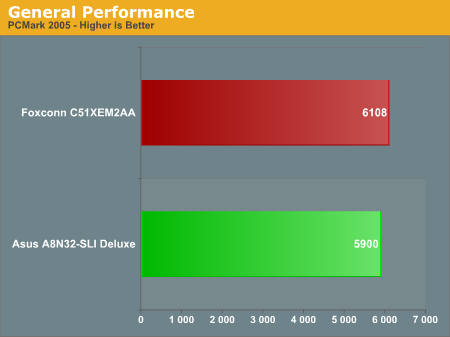
The margins are little wider at 4% in the PCMark05 results, but the margin of error in PCMark05 is also slightly larger. It is obvious from our test results so far that either platform provides excellent results. If you have a socket 939 platform and are happy with its feature set then we do not see a reason to upgrade at this time.
Rendering Performance
We have added the Cinebench 9.5 and POV-RAY 3.6 benchmarks as they heavily stress the CPU subsystem while performing graphics modeling and rendering. We utilize the standard benchmark demos in each program along with the default settings. Cinebench 9.5 features two different benchmarks with one test utilizing a single core and the second test showcasing the power of multiple cores in rendering the benchmark image.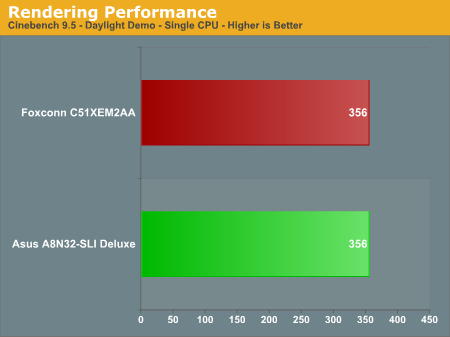
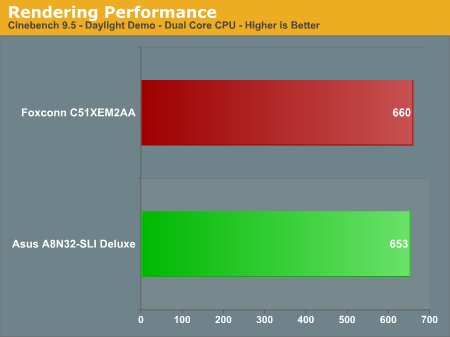
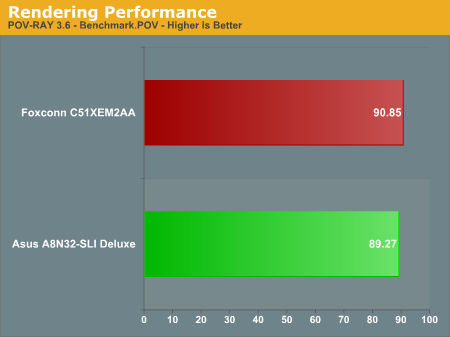
The nForce 500 desktop platform shows small and almost imperceptible differences in these benchmarks, with the 590 AM2 performing slightly better in the demanding POV-RAY benchmark. Once again both platforms are performing equally.










64 Comments
View All Comments
artifex - Wednesday, May 24, 2006 - link
If they want the TCP/IP acceleration to be a draw for that crowd, they'd better fix this thing with firewalls not being supported. I could not imagine running a corporate server like that. And it's a bit much for them to hold out Vista as a possible fix, as many of us would like to wait a while before dropping Vista into production environments. Like a couple years. :)
Jaylllo - Wednesday, May 24, 2006 - link
Is it just me, or do ATI/NVIDIA/INTEL make up a boatload of stupid names for simple features?afrost - Wednesday, May 24, 2006 - link
So when do we get low power chipsets to go with our low power CPUs?Nvidia's mid to high end GPUs use less power than ATI GPUs....but it's the other way around for chipsets......????
seems odd
Gary Key - Wednesday, May 24, 2006 - link
Rumor has it, in the late fall. ;-)
FinFET - Wednesday, May 24, 2006 - link
On this page http://www.anandtech.com/cpuchipsets/showdoc.aspx?...">http://www.anandtech.com/cpuchipsets/showdoc.aspx?... the nForce 550's summary reads"Several of the higher and options have been dropped from the 550 chipset"
I believe you meant
"Several of the higher end options have been dropped from the 550 chipset"
Wesley Fink - Wednesday, May 24, 2006 - link
Corrected.peternelson - Wednesday, May 24, 2006 - link
How can you say there is not improvement?
The 590SLI gives increased number of PCIE lanes to total 46.
These are available as 16, 16, 8, and six individual 1x connections.
Assuming some slots on the motherboard:
x16 slot: card x16 nvidia graphics card
x16 slot: card x8 ARECA EIGHT SATA 300 HARDWARE RAID CONTROLLER
x8 slot: card x8 MYRINET 10 GIGANET hardware accelerated LAN
I'm not particularly interested in consumer level SATA and LAN but consider them a free bonus. What MATTERS is that there is enough BANDWIDTH to use some PROPER peripherals without bottlenecks.
Egglick - Wednesday, May 24, 2006 - link
The only new "feature" I'm really interested in is the TCP/IP acceleration, which lowers CPU usage. The rest of it is a bunch of gimmicks and garbage as far as I'm concerned. I'd rather not use those "features" at all, as they're much more likely to cause problems than any sort of performance boost.When I think of that, coupled with their stupid SLI Memory program (another gimmick), my view of NVidia's chipsets is significantly lowered. When the time comes for me to upgrade, I'll be strongly considering ATI's chipset offerings instead.
bob661 - Thursday, May 25, 2006 - link
Egglick,Your name should be Buttlick with that comment. So, let me get this straight (or gay depending on which way you swing), these extra features that Nvidia is giving us are apparently no good since you say so. The rest of us might as well just shut off our computers, grab a pr0n mag, and spank it like it's 1999. Jesus, who needs a brain with you around.
Pirks - Wednesday, May 24, 2006 - link
Yeah, right... ATI are completely smoke'n'mirrors free guys... cool! :)